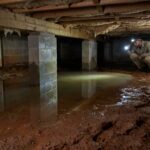Essential Guide to Effective Foundation Repair: Protecting Your Home from Structural Damage
When it comes to home maintenance, foundation repair may not be the first thing that pops into your mind. After all, it’s easy to overlook what’s below ground when you’re busy admiring the new paint on your walls or the lovely wreath on your front door. However, protecting your home’s foundation is akin to wearing a seatbelt; you might not think about it until you really need it. This essential guide will provide you with all the information you need to understand foundation issues, recognize the signs of damage, and implement effective solutions to keep your home standing strong.
Understanding the Foundation
Let’s start off by getting acquainted with the unsung hero of your home—the foundation. Your house’s foundation is the bedrock upon which your entire home rests, literally and figuratively. It bears the weight of the structure, keeping it stable and safe. Most homes are built on either a concrete slab or have a basement, and the condition of your foundation is crucial for your home’s integrity.
But foundations are not invincible. They can suffer from various issues due to moisture fluctuations, poor drainage, soil movement, and even the occasional overzealous tree root thinking it’s a good time for a little underground adventure. These factors can lead to significant structural damage if not addressed promptly.
Signs of Foundation Problems
You may wonder how to spot potential foundation issues before they escalate into a full-blown crisis. Fortunately, your home will often give you warning signs. Here are some common indicators that your foundation might need attention:
1. **Cracks in Walls**: If you’ve suddenly become the proud owner of new cracks on your walls or ceilings—especially if they seem to be widening or deepening—it’s time to call in the experts. Horizontal cracks can be particularly concerning since they often signal significant structural stress.
2. **Uneven or Sagging Floors**: Walk through your home and pay attention to how level your floors are. If you feel like you’re in a funhouse, it may be time to investigate further. A floor that feels like it’s auditioning for a role in a disaster movie is not a good sign.
3. **Sticking Windows and Doors**: If your windows and doors have decided to adopt their own personal struggle against opening and closing, it could be more than just a case of spring humidity or a mischievous building settling. Sticking or misaligned doors can indicate that your home’s structure is shifting away from its original form.
4. **Gaps in Trim**: Notice any gaps forming between your trim and the walls? Such openings can hint at foundational problems. Look for gaps that weren’t there before; this is not an aesthetic update that adds character to your home.
5. **Water Accumulation**: Puddles in your basement or the yard after a rainstorm may point to drainage issues that can lead to serious foundation problems down the line. Your foundation should feel dry and secure, not like an impromptu swimming pool.
If you notice any of these symptoms, don’t play a game of “wait and see.” Addressing foundation issues early can save you a mountain of stress and an avalanche of money in repairs later on.
Types of Foundation Problems
Foundation problems can often be classified into a few categories, each requiring a unique approach to repair.
1. **Settling**: This is the gradual sinking of a foundation due to soil erosion or compaction. It’s as if your house thought it could take a little nap and then found it was too cozy to get up again.
2. **Heaving**: This occurs when the soil beneath the foundation swells due to moisture, causing the foundation to rise. Imagine being lifted out of bed unexpectedly—definitely not a situation you want for your house.
3. **Cracking**: Cracks in the foundation itself can come from a variety of sources, including extreme temperature changes or shifts in the soil. Vertical cracks may not be as alarming as horizontal ones, but they still warrant investigation.
4. **Pest Infestation**: Certain pests, such as termites, can weaken your foundation by hollowing out beams. Even though termites might have their own agenda, you don’t want them tearing down your house while you’re busy binge-watching your favorite show, do you?
Repair Techniques
Once you’ve identified a problem, it’s time to dig into some solutions. Trust me; you don’t want to DIY your way through this process unless you want to earn a PhD in Structural Damage. Here are some common repair methods employed by professionals:
1. **Foundation Underpinning**: This method involves extending the foundation’s depth to stabilize it. Much like getting a taller chair for your table, underpinning gives your house a sturdy lift.
2. **Piering**: This technique uses metal piers to support your foundation. Think of piers as little stilt houses for your home, ensuring it doesn’t sink too low into the ground.
3. **Slabjacking**: If your concrete slab foundation has settled, slabjacking can raise it back to its original position using a mixture injected beneath the slab. Just imagine your beloved pet suddenly gaining the ability to float back to its rightful place, only without the magic carpet.
4. **Drainage Solutions**: Addressing drainage issues can help prevent future problems. This may involve installing gutters, downspouts, or even a more elaborate French drain system. Remember, water is great for plants but terrible for foundations.
5. **Wall Anchors**: If you’re dealing with bowing basement walls, wall anchors might be a solution. They stabilize your walls using a combination of plates and cables. It’s like giving your walls a supportive hug until they feel secure again.
Choosing the Right Contractor
Selecting a skilled contractor to handle your foundation repairs is critical. Do your homework; the last thing you want is to end up with a contractor who believes “fixed” is a relative term. Here are a few tips for selecting the right professional:
1. **Do Your Research**: Look for local contractors with positive reviews and strong references. Online platforms can offer a wealth of information, but so can your neighbor who’s a seasoned DIY expert (or thinks they are).
2. **Get Multiple Quotes**: Don’t settle on the first person who says they can fix your foundation. Compare services, prices, and time frames. It’s an investment; you wouldn’t buy a car without taking it for a test drive first, right?
3. **Ask About Warranties**: Make sure your chosen contractor offers warranties on their work. A good warranty is like a safety net; if something goes wrong, you’ll want to be cushioned.
4. **Check Qualifications**: Ensure the contractor is licensed and insured. A contractor who isn’t properly insured can land you in hot water if anything goes awry during the repair process.
5. **Trust Your Gut**: Finally, trust your instincts. If something feels off during your interactions, don’t hesitate to continue your search. You want someone whose expertise makes you feel confident—not a twinge of anxiety.
Maintaining Your Foundation
After investing time and money into repairing your foundation, one might think the job is done—unfortunately, that’s not quite how life works. Just like a well-tended garden, your foundation requires ongoing care and attention. Here are some tips for maintaining your home’s foundation:
1. **Manage Landscaping**: Be mindful of how you landscape around your home. Trees should be planted away from the foundation to avoid intrusive roots, and mulch should be kept clear of the foundation to prevent water pooling.
2. **Monitor Drainage**: Regularly inspect your gutters and downspouts to ensure they’re functioning correctly. If you discover clogs, channeling water away from your foundation will help prevent future issues.
3. **Watch the Weather**: Keep an eye on heavy rains or droughts. Both extremes can impact your foundation, so it’s wise to adjust your drainage strategies accordingly.
4. **Conduct Regular Inspections**: Routinely check for any signs of damage, especially after harsh weather. Early detection is key to avoiding expensive repairs down the road.
5. **Stay Educated**: The more you know about your foundation and how it works, the better equipped you’ll be to spot potential issues. Knowledge truly is power when it comes to home maintenance.
Conclusion
Taking care of your foundation is no small task, but with the right knowledge and tools, you can protect your most significant investment—your home. By staying vigilant for signs of trouble, employing effective repair techniques, and selecting the right professionals, you can ensure that your foundation remains as solid as the day your home was built. After all, a happy home is a structurally sound home. So, roll up your sleeves, dig in, and show your foundation the love it deserves!


